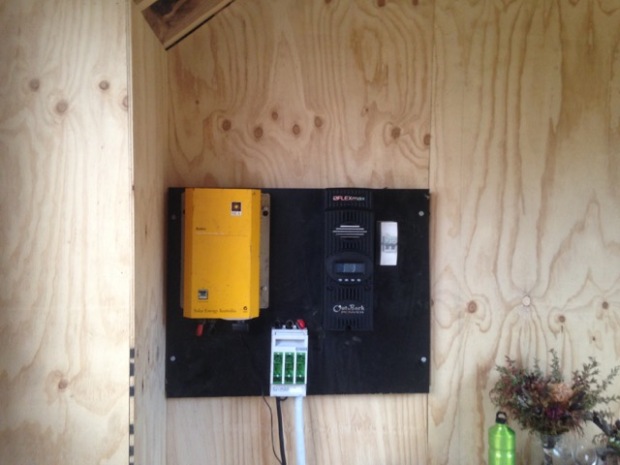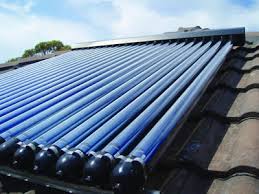I have put off starting this post, partly because my solar set up still feels like it’s in the early stages, and partly because there’s so much to wrap my head around for this part that it’s hard to know where to start putting it all into words.
When I was first researching my power options I had to go right back to basics, to learn what Watts, Amps and Voltage even meant. I found this tutorial site one day and it is definitely worth a look if you’re in the same boat I was. Step by step explanations for all the basic terms and equations are available. Highly recommend!
240 volt versus 12 volt power
One of the first decision I had to make was about the voltage I would run through my house, 240 volt (standard powerpoint type power) or 12 volt (common in Caravans). 12 volt has some appeal as it usually means less energy consumption, this is advantageous if you’re running off solar and need to minimise your usage. 240 volt power is far more common in houses and makes buying lights and appliances much cheaper and easier.
One thing that took me longer than it should’ve to get was the difference between DC and AC power. DC power stands for direct current (where the electric current flows in one direction only) and is the form of power produced by batteries. AC stands for alternating current, where the electric current has been modified and the current now reverses directions many times a second. I’m sure there are very important scientific reasons for this happening, none of which I can explain to you. The important thing to understand is that DC means it’s running straight from a battery. AC means it’s running through an inverter. Commonly, 240v like we have in houses is AC power. 12v caravan power is most commonly DC power, as these often run from solar. I just assumed AC meant things were always 240v power and DC was another term for 12 volt. WRONG. Made for a few interesting chats with my electrician and solar guy, before I finally got things sorted in my brain.
Originally, I thought about running a dual system – running my lights on 12v DC from solar and plugging the rest into an extension lead from mains power to run the appliances. In the end I decided to put my money where my values really are and commit to making this little house sustainable in its energy usage. Setting up an off grid solar power system isn’t a small investment and I can’t even say that the financial returns will be worth it in the short term. It would definitely be cheaper to just connect an extension lead to regular power and pay for the small amount of electricity I’d be using. If saving money was my only motivation then that’s probably the way I would’ve done it. But I’m down the rabbit hole now with this experiment in tiny living, it might be the only chance I get to try it properly. It only makes sense to keep going! So, I’m going fully solar. It’s a whole new world, but also pretty exciting.
The solar stuff makes a lot more sense after having chatted to a solar expert. I only wish I’d done it before I’d gotten excited and hired the electrician to come in and do the wiring. There were a few touch and go moments where I was slightly worried that the wiring might’ve had to be redone to suit a solar system, but it’s all worked out in the end. It’s slightly confusing and will have a few quirks, but it’ll work.
Overall, the system looks like this:
- All power coming from solar panels to the batteries (starting as DC power)
- All power running from batteries into the house through an inverter (changing all power to 240v AC)
- 240v AC running to all power points in the house (grey wires in the picture)
- Wiring branching off this with transformers, stepping all power for lights down from 240v AC down to 12v AC (black wires)

Advantages to this set up are:
- Standard 240v power means I can run normal appliances on my power points
- 12v lighting should be more energy efficient and draw less power from my system than 240v lights
- 12 volt wiring is approx half the price of the 240 volt wiring meaning it was cheaper to rough in
- Being off grid means I’ll produce all of the power I’ll consume. I’ll have no electricity bills, independence from blackouts and all the good feels from knowing that my energy consumption is sustainable and not contributing to ongoing damage to our environment.
Disadvantages include:
- An inverter is needed to change power from DC to AC if you want to use regular appliances and are a pretty standard part of a solar system. But keep in mind that inverters draw power whenever they’re running. My solar guy suggested that these will go into sleep mode when power isn’t being drawn through the system to save energy, but it means even having one thing plugged in overnight (phone charger, for example) will keep the whole system on and churning through power. The inverter can’t really be classed as a ‘disadvantage’ as such, but it’s still an extra element to keep in mind if you’re considering 240v power.
- Transformers (stepping voltage down from 240v to 12v for my lights) also use a small amount of constant power, even when the lights aren’t on. Even though it’s not much power, this feeds back into the above problem. Having the transformers on will keep the inverter running and will be drawing double the amount of extra power for nothing. The solution for this is a mains/manual switch to turn off the transformers before bed or when leaving the house for the day. Here’s hoping the mains switch will be within reach of my bed, otherwise I’ll be climbing up to conveniently turn my loft lights off from bed before climbing back down to put the whole house to bed. (Quirk).
- 12 volt lighting requires 12 volt light fittings. Unless you’re looking for ugly bulky caravan lights (sorry caravans) these aren’t so easy to come by. Would definitely be easier to source nice 240 volt fittings.
If I had my time again, I would take the extra cost of the 12 volt wiring and the extra energy consumption to have the whole thing wired up for 240 volts. This would simplify things and probably would work out to be the same cost once I factor in the transformers that all of my lights will now need. Lots to consider in these systems but I appreciate the way it forces you to be more conscious of your consumption and quite intentional in what you use. Definitely fits into the tiny living ethos!
More details to come on batteries and estimating the size of your set up.






